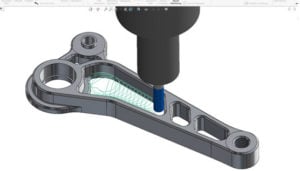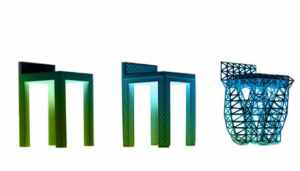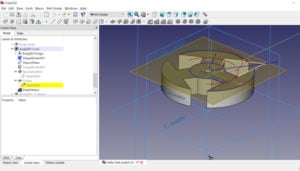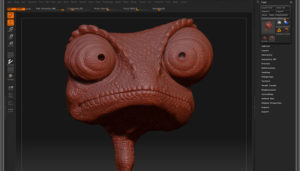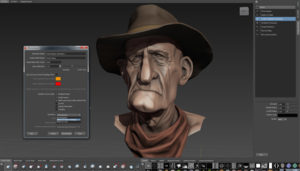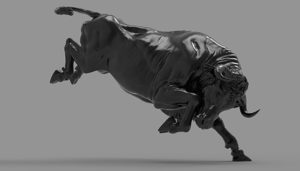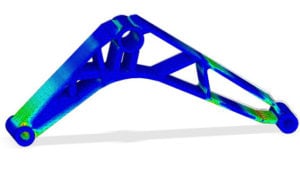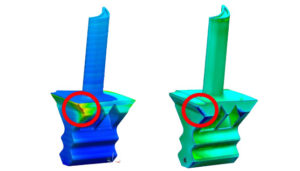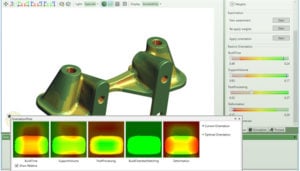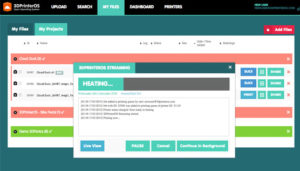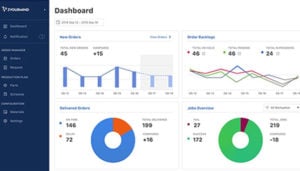At the origin of any 3D printed part is a digital model of this part, created or adjusted on 3D modeling software. When talking about 3D modeling software, most often we mean CAD software, but it can also refer to optimization and simulation software, or to slicing and STL file repairing software. Additionally, there also exists on the market software to manage production flows, which is unrelated to modeling but increasingly useful for companies that wish to industrialise their production. In fact, the realm of software for 3D printing is rich, which is why we’ll break it down for you below!
In terms of modeling, it is important to remember that many parameters have to be taken into account when working on a 3D model. It is therefore important to plan ahead for complex geometries, mechanical characteristics, weight, cost, 3D printing supports, etc. In this guide, we review the different types of 3D printing-related software that exist on the market.
3D Modeling Software
When it comes to modeling a part, the user has several options: solid, surface or organic modeling. The final choice of the software will be made quite naturally according to the need and the rendering that one wishes to give to the 3D printed object. It can also be done depending on the 3D printing technology or even the desired material.
Solid Modeling
For solid modeling, CAD software is often the most appropriate solution. The choice is wide for this category of software. When choosing which CAD software to model on, you should be guided first and foremost by your level of expertise. If you are a beginner, go for an accessible solution because modeling can quickly become very complex. Your choice will also depend on some of the features you might need, usually dictated by the industry you work in. Finally, ask yourself if you want a cloud-based solution or not.
CAD software often uses parametric design which, as its name suggests, allows a 3D model to be defined by easily replaceable parameters: modeling takes form through programming, as opposed to drawing.
This type of solution will allow the user to change the characteristics of a part, whether it is its length, angle, coordinates with respect to a reference point or distance. It all starts with a drawing composed of closed 2D curves; then, the user adds a number of functions to create a 3D shape.
This technique is similar to generative design, which makes it possible to define design objectives and constraints and to analyze the performance of each parameter (material, weight, strength, cost, etc.). The software explores all possible permutations of a design, quickly generating design alternatives. It tests and learns at each iteration what works and what does not.
Parametric design is more rigid than direct modeling and will be mainly used by mechanical engineers and industrial designers. Among the most popular 3D printing software that integrates these functions are Solidworks, Catia, CREO, Fusion 360 and FreeCAD for the free version.
It should be noted that, according to a survey conducted by 3DHubs among 750 professionals, Solidworks is the most widely used CAD software, whether by engineers (50%) or designers (49%). It is followed by AutoCAD, Fusion 360 and Rhino solutions, which target designers.
- Parametric modeling with Solidworks
- Generative modeling with Autodesk
- Parametric modeling with FreeCAD
Surface Modeling
This type of design is generally appreciated by users looking for aesthetics. As its name suggests, surface modeling software defines the surface of the object and not its solid interior. In most cases, they are used in artistic sectors, particularly in the animation and 3D compositing markets. The most well-known solutions are CATIA by Dassault Systèmes, Blender or Rhinoceros. This, for example, is a tool that is particularly appreciated by industrial designers and architects.
Organic Modeling
This concept allows the creation of free form surfaces with very complex details and is generally used to design characters or sculptures. The two most widely used 3D printing software on the market who fit under this umbrella are undoubtedly Pixologic’s ZBrush and Autodesk’s Mudbox. They are very well known in the film industry, or among jewelry designers.
Once the 3D model has been created on a modeling software, the next step is to ensure that it is 3D printable. Many solutions exist to optimize or even simulate the printing of the part, thus reducing the risk of printing errors.
- ZBrush is one of the most popular digital sculpting tools
- The Mudbox software solution
- Organic modeling software can be used to create very detailed parts
Simulation & Optimization Software
Topological optimization software cannot be overlooked when it comes to modeling and simulation. These tools make it possible to define the best distribution of material in a given volume, subject to constraints. In other words, it removes the material from a part when it is not necessary for its proper functioning. Topology optimization makes it possible to respect load and resistance constraints, while considerably reducing the final weight. These optimization software offer more complex geometries, weight savings and therefore increased performance in industries such as automotive or aeronautics and pair well with the capabilities of 3D printing. Among the existing solutions, we can mention solidThinking Inspire, Ansys or 4D_Additive, or Crea Simulate.
Simulation software allows you to digitally predict the results of a 3D printing process. They will offer valuable time to the user since they detect possible printing errors in a few minutes, thereby reducing the costs associated with printing waste. The user can simulate a number of parameters: distortion, temperature or post-processing. It also makes it possible to assess the need for printing supports and identify critical areas where deformations may occur.
The parameters to be simulated depend on the printing technology used. For example, for Fused Deposition Modeling (FDM), the main focus will be on assessing the risks of warping – in these cases, the simulation will help to determine whether the part needs to be redesigned or whether the adhesion to the plate should be increased for example.
If Selective Laser Sintering has been used, you may observe the creation of more or less hot areas on the piece, resulting in deformation of the part or poor surface quality. By simulating the thermal properties of your 3D model, these errors can be avoided when printing.
- Topological optimization software optimizes material distribution
- Siemens’ simulation tool
- EOS software enables to visualize thermal zones
Slicers and software to repair your STL file
Slicers
It is the must-have when you want to 3D print: the slicer, or slicing software, cuts the 3D model into thin digital layers that correspond to the layers of material extruded by the 3D printer.
The slicer transmits to the printer all the instructions it must follow – these are usually written in a language called G-code. For example, the slicer defines the resolution, the printing speed or the layer height. It is therefore a central software in the additive manufacturing process. For FDM 3D printers, there are two categories of slicers: universal open source software such as Cura (developed by Ultimaker), Repetier or Slic3r or paid software such as Simplify3D but also proprietary software such as ReplicatorG at MakerBot, ZSuite at Zortrax or Voxelizer at ZMorph.
You can find our selection of slicers for 3D printing HERE.
Repair
While simulation software detects errors before printing, STL repair software can correct them: it is a key asset in the printing process. Some slicers are able to detect the basic defects that exist in the 3D file but they do not necessarily detect everything.
Fortunately, there is dedicated software available to repair damaged STL files, ensuring an optimal 3D printing process. Some tools will be available for download, others are available online, open-source or not. Whatever your level, you should be able to find an appropriate solution for you. Among the best known are NetFabb or MakePrintable.
You can find our selection of 3D file repair software HERE.
3D Printing Management Tools
If you need to run multiple 3D prints at the same time in different locations or your company has a large supply of machines, there are 3D printer management solutions available to simplify workflows. These generally include remote monitoring, multi-user management, optimized production bin filling or enhanced machine control, all to facilitate the user experience and automate manufacturing steps.
Some of the software currently available include Octoprint, Astroprint or PrintRun. 3D Printer OS, for example, connects different 3D printers in a network to coordinate all your printing and increase your productivity. For manufacturers, software publishers such as Dassault Systèmes, Siemens, 3YOURMIND and AMFG have also launched solutions for this industry demand.
- Astroprint helps the 3D printing workflow
- 3D Printer OS solution
- The 3YOURMIND platform
Other 3D Printing Software
As you will have understood, there are many tools when it comes to 3D printing software. To finish off this overview, we wanted to draw your attention to 2 other types of solutions:
– Software to protect your designs: there are a few solutions on the market to protect your data and allow repeatability and traceability of production. When a user models a part, it can be very important to protect some data, more or less sensitive, and to ensure that digital flows are encrypted. Some software programs now offer to secure the production line, from CAD to production. This is the case, for example, with Identify3D.
– 3D scanning applications: one modeling option is 3D scanning. The user can directly create a 3D file from an object they have scanned. Today, many scanners exist, but they can sometimes be complicated to use or quite inaccessible. 3D scanning applications are a good alternative. Some are downloadable to a smartphone, allowing you to scan directly from a phone’s camera. Related to this last point is photogrammetry software, which as its name suggests uses photographs to recreate a digital model. You can take a look at our ranking on the best photogrammetry software on the market if you wish to learn more.






